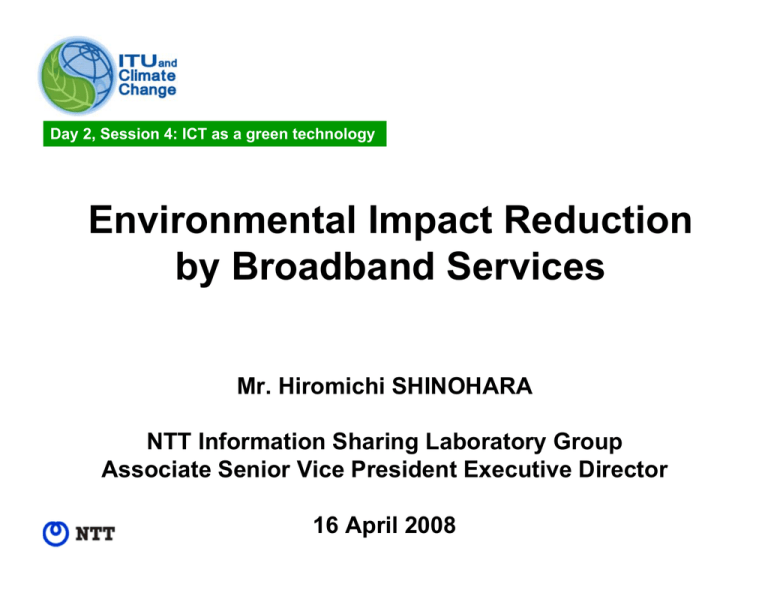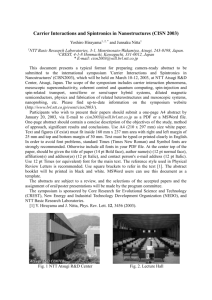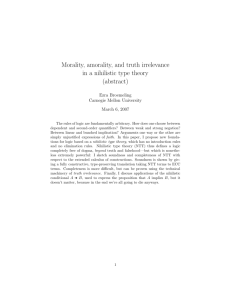Environmental Impact Reduction by Broadband Services
advertisement

Day 2, Session 4: ICT as a green technology Environmental Impact Reduction by Broadband Services Mr. Hiromichi SHINOHARA NTT Information Sharing Laboratory Group Associate Senior Vice President Executive Director 16 April 2008 NTT is … NTT Group comprises NTT (the holding company) and 515 subsidiaries and affiliates. The group's principal business activities are communications: regional, long-distance and international, mobile, and data communications. Copyright 2008 NTT 12000 120 10000 100 8000 80 6000 60 4000 40 2000 20 0 0 2003 2004 2005 2006 2007 Year (1$=100 yen) Other System integration Billions of dollars Billions of yen Operating Revenue Sale of telecommunication equipment IP/packet communications service Mobile voice-related service Fixed voice-related service NTT Group CSR Charter Our commitment As a leader of the information and telecommunications industry, the NTT Group is committed to providing reliable, high-quality services that contribute to the creation of a safe, secure, and prosperous society through communications that serve people, communities, and the global environment. * We shall strive both to reduce our own environmental impacts and build environment-friendly forms of communications and to provide information and communications services that help to reduce the impact of society as a whole on the global environment. NTT Group Principal Activity Plan targets (direct effect) NTT Group’s Vision for Environmental Contribution (indirect effect) * Team NTT comprises all NTT Group employees, including temporary employees, contract employees, employees of our Copyright 2008 NTT corporate partners, and also former employees who endorse the NTT Group's CSR activities. Environmental impact of NTT Group INPUT OUTPUT Consumption Emissions/waste Electricity: 8.51 billion kWh CO2: 3,776,000 t Virgin pulp: 290,000 t Final disposal: 32,000 t Fuel: 47,000 kl NTT Group businesses To be recycled: 635,000 t Gas: 74.64 million m3 Water: 14.52 million m3 FY 2006 Copyright 2008 NTT NTT Group’s Principal Activity Plan targets (by 2010) Prevention of global warming By 2010, achieve the following reductions in CO2 emissions per unit compared with 1990 levels: Total for telecommunications carriers: Reduction of at least 35% per subscriber. Telecommunications carriers: NTT East, NTT West, NTT Communications, and NTT DoCoMo Total for solutions companies: Reduction of at least 25% per unit sale Solutions companies: NTT DATA, NTT COMWARE, NTT Facilities, etc. Waste reduction Reduce amount of final disposal waste to no more than 15% of 1990 levels. (This target has been achieved, as of fiscal 2005.) Reduction in paper use Reduce consumption of virgin pulp to 80% or less of 1990 levels. (This target has been achieved, as of fiscal 2004.) Copyright 2008 NTT Initiatives to prevent global warming (1) Initiatives to reduce power consumption Reducing CO2 emissions through Total Power Revolution (TPR) campaign, which cut electricity consumption by 124 million kWh (BAU) in 2006. - To promote R&D regarding power-saving of ICT systems - To promote energy management schemes for the 4000 buildings that NTT occupies throughout Japan - To deploy energy-efficient electrical devices and air conditioning equipment and switching - To use power-saving DC power supplies for broadband equipment such as servers and routers - To use clean energy systems such as solar and wind power Copyright 2008 NTT Initiatives to prevent global warming (2) Initiatives to reduce environmental impacts in logistical and sales operations - NTT Group shipped 5830 tons of goods using transportation modes with low CO2 emissions, like rail and ferry services, in 2006. - NTT Group had a total of 603 low-emission vehicles, including 387 hybrid cars and 216 cars that run on natural gas, in 2006. Establishing and maintaining environmental management systems Environmental solutions and efforts to reduce the environmental impact of NTT Group products and services Urban heat island mitigation Copyright 2008 NTT CO2 reduction effect of Internet connection service with PON (passive optical network) system CO2 reduction of 57% by sharing an optical fiber Lifecycle CO2 emissions (kg-CO2) Terminal equipment SS* ONU 100 Splitter Optical cable Manhole Concrete pole 50 0 Access facilities PON Terminal equipment Access facilities Building facilities IP network Conditions: PC used for 1 h and one ONU used for 24 h in a day CO2 emissions of a subscriber in metropolitan area during a year *: Single Star FTM Switch Splitter Router Optical line terminal IP network Building facilities Additive by PON Improvement by PON Copyright 2008 NTT NTT Group Vision for Environmental Contribution The NTT Group is helping to reduce the environmental impacts of its customers and society as a whole by developing and disseminating ubiquitous broadband-based ICT services that promote positive changes in lifestyles and business models. Reduction target for 2010 Reductions in CO2 emissions as a result of ICT services - CO2 emissions from providing ICT services = Reduction in CO2 emissions of 10 million tons Copyright 2008 NTT CO2 reduction effect of broadband services Evaluated broadband services provided by NTT Group ・FLET’S ADSL is an Internet connection service with flat-rate monthly charges using an ADSL (asymmetric digital subscriber line) line. ・B FLET’S is an Internet connection service with flat-rate monthly charges using an optical fiber cable (FTTH). ・FOMA is a W-CDMA-based 3G mobile communication service (W-CDMA: wideband code division multiple access). Evaluation method Step 1 We determined the ICT services and actions used in Japan and also assumed the conventional services and actions to achieve the same objectives without using the broadband services. Step 2 We surveyed the average usage condition of each broadband service by sending questionnaires to users. Step 3 Based on the survey results, we assessed lifecycle CO2 emissions for ICT and conventional services and actions over a single line or access channel during a oneyear period. Copyright 2008 NTT ICT services/actions using broadband services and conventional ones B FLET’S, FLET’S ADSL and FOMA (16 services) ICT services/actions Conventional services/actions Email Mail letters Receive information by e-magazines and e-newsletters Subscribe to newspapers Web pages, bulletin boards, chatting, blogging Purchase magazines at store Quizzes, prizes, questionnaire replies Mail postcards Internet auction Exchange goods in person Internet shopping Mail-order … … B FLET’S and FLET’S ADSL only (3 services) ICT services/actions Conventional services/actions Download music Purchase CDs at store Download movies Purchase DVDs at store … … ICT services/actions Conventional services/actions FOMA only (3 services) Download ring tones Purchase CDs at store Retrieve maps and location information Purchase maps at store … … CO2 reduction effect of broadband services FLET’S ADSL 185 Conventional services/actions ICT services/actions 0 B FLET’S 50 100 Conventional services/actions 150 200 188 ICT services/actions 55% (104 kg) 85 0 FOMA 28% (52 kg) 133 50 Conventional services/actions 100 150 200 150 200 Copyright 2008 NTT 140 ICT services/actions 0 82% (114 kg) 26 50 100 Lifecycle CO2 emissions (kg-CO2 per year) CO2 reduction effect of the entire NTT Group 4.5 35.0 CO2 reduction effect of B FLET'S CO2 reduction effect of FLET'S ADSL 30.0 CO2 reduction effect of FOMA 3.5 3.0 Subscriptions of B FLET'S 25.0 Subscriptions of FLET'S ADSL Subscriptions of FOMA 2.5 20.0 2.0 15.0 1.5 10.0 Subscriptions (million) CO2 reduction effect (million ton) 4.0 1.0 5.0 0.5 0.0 0.0 2004 2005 2006 FY CO2 reduction effect in 2006, 4.14 million tons, is larger than CO2 emissions of the entire NTT Group, 3.78 million tons. Copyright 2008 NTT Summary (1) • Providing users with broadband and ubiquitous services can not only improve their convenience but also reduce energy consumption by making activities more efficient. On the other hand, both resources and energy are consumed in providing broadband and ubiquitous services. • NTT promotes power consumption reduction with its total power revolution (TPR) activity etc. because NTT consumes a lot of electricity: 8.5 billion kWh. • For FTTH (fiber to the home), the CO2 emissions were decreased by a passive optical network (PON) system, in which multiple subscribers share an optical fiber. Copyright 2008 NTT Summary (2) • NTT contributed a CO2 reduction of 4.14 million tons by providing users with broadband and ubiquitous services in 2006. • To promote global warming countermeasures through the use of ICT worldwide, it is necessary to standardize the criteria used for determining the contribution by the use of ICT . • In ITU, I would like to promote standardization of the criteria used for this calculation. Copyright 2008 NTT


